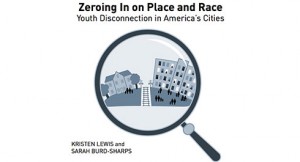Zeroing in on Place and Race: A New Youth Disconnection Report
 •
•
We know that place matters and that race and income influence access to opportunity in America. Your zip code, skin color and bank account should not determine how far you go in life. But too often, that is the case.
Now a fascinating new report from Measure of America, Zeroing In on Place and Race: Youth Disconnection in America’s Cities, explores the impact of these factors on young adults. The report provides fresh insight on youth who are most at risk for disconnection in America’s largest cities and recommendations about how to prevent disconnection from happening in the first place.
Did you know:
- More than 1 in 5 black youth and 1 in 5 Native American youth are disconnected from school and work
- 1.4 million Hispanic young adults, ages 16-24, are disconnected
- 45 percent of the overall disconnected youth population in the U.S. is white — 2.5 million young adults
The fact is, too many disconnected youth are invisible. By breaking down new information on the metro areas where most Americans live and looking closely at race, ethnicity and socio-economic status, a clearer picture of our young adults and the challenges they face emerges.
The bottom line: white, Hispanic, Native American, Asian and black youth live in vastly different worlds, even when they grow up in close proximity to one another. In the metro areas of Chicago, Washington DC and Philadelphia, for example, young adults living in a few predominately black neighborhoods are 10 times more likely to be disconnected than youth living in a few nearly all-white neighborhoods in each of these cities.
De facto residential, racial and economic segregation, which have been increasing since the 1970s, exacerbate youth disconnection and cut off millions of young Americans from access to opportunity.
The picture around the country varies greatly.
Youth disconnection rates are well below the national average of 13.8 percent in several major metro areas, including: Omaha; Bridgeport, Conn.; Boston; Minneapolis-St. Paul; and Ogden-Clearfield, Utah.
But they are much higher – about 20 percent – in several southern and western cities, including: Las Vegas; McAllen, Texas; Lakeland, FL; Bakersfield, CA; and Memphis.
Youth disconnection doesn’t happen all of a sudden. It unfolds over years. That means there are multiple chances for effective interventions that can change the trajectory of millions of young lives at risk for disconnection and put them on a successful path.
High quality schools; access to mentors and apprenticeships; exposure to civic engagement opportunities; and second chances for young, nonviolent offenders are among the solutions recommended in the report – priorities that align with our coalition’s call to action for youth employment: We Got This.
Today, we are all paying a steep price – economically and socially – for the 5.6 million youth who are disconnected from school and work.
The report estimates that the cost of just a handful of factors associated with youth disconnection, such as incarceration, Medicaid, public assistance and Supplemental Security Income payments, amounted to $26.8 billion for 2013 alone. And that’s not even counting the devastating human costs of wasted talent and potential and the negative consequences for families, neighborhoods and communities.
Zeroing In on Place and Race, which Opportunity Nation was proud to support, clearly shows that disconnected youth face challenges beyond what they can tackle alone.
We all have a role to play – and we all reap the benefits – when the rising generation has the tools and supports they need to embark on meaningful education and career pathways and get their fair shot at the American Dream.
We believe the data in this report comes at a critical time for the opportunity movement and will help advance the national conversation – and smart, bipartisan solutions – regarding the youth disconnection crisis in America.









